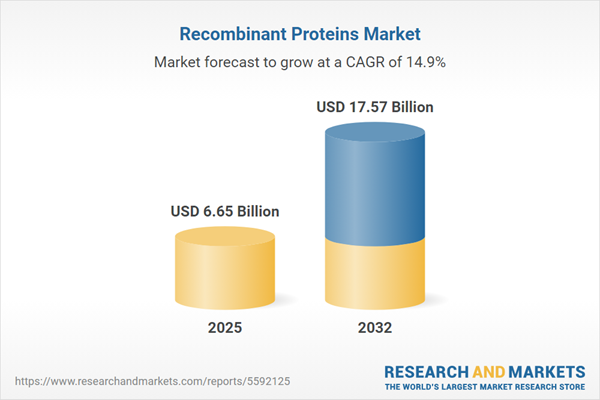Speak directly to the analyst to clarify any post sales queries you may have.
The recombinant proteins market is advancing rapidly, shaped by innovations in bioprocessing and strategic adaptation across healthcare, diagnostics, and pharmaceutical manufacturing. Senior stakeholders face shifting regulatory and procurement landscapes as industry leaders implement new technologies and respond to changing global trade dynamics.
Market Snapshot: Recombinant Proteins Market Growth and Development
The global recombinant proteins market grew from USD 5.80 billion in 2024 to USD 6.65 billion in 2025. With a CAGR of 14.85%, market value is forecast to reach USD 17.57 billion by 2032. This strong growth trajectory reflects expanding application areas across diagnostics, therapeutics, and vaccine development, driven by continuous process innovation and rising demand for biologics in diverse regions.
Scope & Segmentation: Comprehensive Industry Analysis
- Applications: Diagnostics (imaging agents, in vitro diagnostics), research and development (basic research, drug discovery, process development), therapeutics (autoimmune, cardiovascular, oncology), and vaccines (prophylactic, therapeutic).
- Product Types: Cytokines, enzymes, growth factors, hormones.
- Expression Systems: Bacterial hosts (E. coli), insect systems (baculovirus expression), mammalian platforms (CHO cells, HEK cells), plant hosts (transgenic plants), and yeast (Pichia pastoris, Saccharomyces cerevisiae).
- End Users: Academic and research institutes, contract research organizations, diagnostic laboratories, pharmaceutical and biotech companies including large pharma and small/medium enterprises.
- Form: Liquid form and lyophilized form.
- Sales Channels: Direct sales, distribution partners.
- Regions and Countries: Americas including North America (United States, Canada, Mexico) and Latin America (Brazil, Argentina, Chile, Colombia, Peru); Europe, Middle East, and Africa including major European economies (United Kingdom, Germany, France, Russia, Italy, Spain, Netherlands, Sweden, Poland, Switzerland), the Middle East (UAE, Saudi Arabia, Qatar, Turkey, Israel), and Africa (South Africa, Nigeria, Egypt, Kenya); Asia-Pacific (China, India, Japan, Australia, South Korea, Indonesia, Thailand, Malaysia, Singapore, Taiwan).
- Leading Companies: Thermo Fisher Scientific Inc., Merck KGaA, Danaher Corporation, Sartorius AG, Lonza Group Ltd., F. Hoffmann-La Roche Ltd., Boehringer Ingelheim International GmbH, Bio-Rad Laboratories, Inc., Bio-Techne Corporation, Abcam plc.
Key Takeaways for Senior Decision-Makers
- Advancements in recombinant protein technology are enabling flexible and high-yield production, expanding possibilities for pharmaceutical research, industrial-scale manufacturing, and clinical use.
- Widespread adoption of digital bioprocessing and real-time monitoring is streamlining workflows, enhancing compliance, and reducing time to market for novel therapies.
- Supply chain strategies are shifting due to evolving global trade policies and local manufacturing initiatives, resulting in increased resilience and agility for stakeholders.
- Sophisticated platform selection, such as cell-free and mammalian systems, is allowing targeted solutions for complex therapeutics and vaccines, meeting the specific needs of various end-user groups.
- Companies are optimizing their value chain through partnerships, mergers, and collaborative R&D, accelerating the transition from development to commercialization and supporting ongoing portfolio diversification.
Tariff Impact: Navigating New Trade Barriers in the US Market
The 2025 United States tariff measures have heightened cost pressures for manufacturers and suppliers, prompting industry players to reevaluate sourcing and contract models. Diversification of supplier bases into Asia-Pacific and Europe, adoption of localized manufacturing, and optimization of raw material utilization have emerged as practical responses. Contract research organizations and diagnostic laboratories are increasingly investing in regional capabilities to counteract potential disruptions, resulting in a more agile and robust supply ecosystem.
Methodology & Data Sources
This report employs a combination of secondary research from scientific publications, regulatory documents, and company filings alongside primary interviews with industry executives, regulatory experts, and end users. Qualitative findings are corroborated through stakeholder engagement and validation workshops to ensure analytical accuracy and insight reliability.
Why This Report Matters
- Strategic, segment-level intelligence enables informed investments, R&D prioritization, and market entry decisions across key regions.
- Clear analysis of compliance challenges and procurement strategies helps industry leaders anticipate risks and leverage opportunities posed by regulatory and trade changes.
- Insights into digitalization, platform evolution, and partnership models empower organizations to optimize operations and accelerate innovation.
Conclusion
The recombinant proteins market is set for sustained global growth, driven by technology innovation, strategic adaptation, and a dynamic regulatory environment. Well-informed stakeholders will shape the next era of biologics and diagnostics through agility and collaboration.
Additional Product Information:
- Purchase of this report includes 1 year online access with quarterly updates.
- This report can be updated on request. Please contact our Customer Experience team using the Ask a Question widget on our website.
Table of Contents
3. Executive Summary
4. Market Overview
7. Cumulative Impact of Artificial Intelligence 2025
Companies Mentioned
The companies profiled in this Recombinant Proteins market report include:- Thermo Fisher Scientific Inc.
- Merck KGaA
- Danaher Corporation
- Sartorius AG
- Lonza Group Ltd.
- F. Hoffmann-La Roche Ltd.
- Boehringer Ingelheim International GmbH
- Bio-Rad Laboratories, Inc.
- Bio-Techne Corporation
- Abcam plc
Table Information
| Report Attribute | Details |
|---|---|
| No. of Pages | 188 |
| Published | October 2025 |
| Forecast Period | 2025 - 2032 |
| Estimated Market Value ( USD | $ 6.65 Billion |
| Forecasted Market Value ( USD | $ 17.57 Billion |
| Compound Annual Growth Rate | 14.8% |
| Regions Covered | Global |
| No. of Companies Mentioned | 11 |









